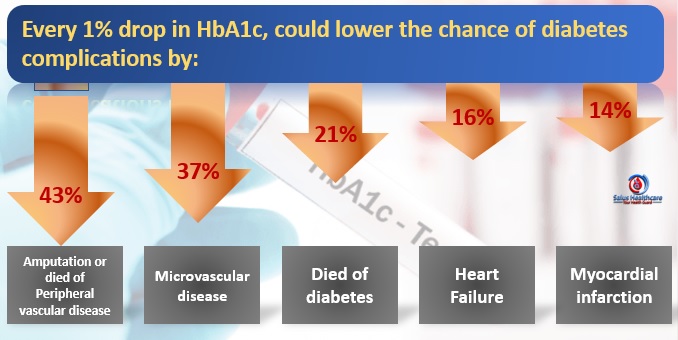Glycated Hemoglobin (HbA1c) Breakthrough Discovery
What is HbA1c
Glycated hemoglobin (can be abbreviated as HbA1c): Heme is the protein inside the red blood cell, responsible for the transport of oxygen and carbon dioxide in the blood. When a glucose molecule in the blood enters a red blood cell, it can directly combine with heme to form glycated hemoglobin, no need the catalyzation of enzyme. Once hemoglobin is bound with glucose, it will remain in this state until the red blood cell dies. According to Western medical research results, the higher the glucose concentration in blood, the more glucose and hemoglobin are combined, and the relative "glycated hemoglobin" will also rise. When glucose is attached to hemoglobin, it won’t fall off until the red blood cell cells decay. The average longevity of red blood cells is 90-120 days, so HbA1c can be used to reflect the blood glucose control during this time.

For diabetic patients, self-monitoring of fasting and postprandial blood glucose values is important, but these values can only represent a very short period of blood glucose control status. These values will be fluctuated during the day, affecting by factors such as diet, exercise, disease, and drugs. Therefore "glycated hemoglobin" value is more important to represent a person's long-term glycemic control. Figure (1) shows the comparison between the daily variation of blood glucose levels and glycated hemoglobin values.

An important indicator of glycemic control in diabetics is "glycated hemoglobin (HbA1C)". The normal value of glycated hemoglobin is 4-6%, and the diabetic patients should maintain at a level below 7%. Patients must be alert and take appropriate medication if it is over 8%. One should immediately adjust the diet, exercise, lifestyle or drug dosage to avoid complications. The World Health Organization (WHO) recommends the following guidelines for the diagnosis of diabetes (Figure 2):

Breakthrough Discovery of HbA1c
The “Natural Herbal Tea” provided by the Association is intended for people with type II diabetes for 20 days via proper diet and exercise. After a detailed analysis of the blood test reports of these patients, the association’s experts found an astonishing "breakthrough". The "Natural Herbal Tea" can significantly improve the blood glucose level and quality of the red blood cells and eventually brings glycated hemoglobin return to a normal level in a short period of time.
Dr. Lam Ping Kuen, the research consultant of the association, certified this breakthrough discovery. Dr. Lin reviewed the reports of patients after taking the “Natural Herbal Tea”, conducted a detailed and in-depth analysis to obtain the following conclusions:
After drinking "natural herbal tea", "glycated hemoglobin" can be improved in a short period of time without relying on drugs (with proper diet and exercise).
Positive Health Effect by dropping 1% of HbA1c
In the 1970s, the United Kingdom conducted a "prospective diabetes study" ¹. Participants were diabetics (more than 5,000 people) from 23 different hospitals. The patient's health status was traced for 10 years. The results showed that there was a significant correlation between the glycated hemoglobin level and a series of related diseases and death risks. According to the data analysis of patients, the risk of microvascular complication, including retinopathy, neuropathy and diabetic nephropathy, is reduced by 37% for every 1% reduction of glycated hemoglobin. The likelihood of amputation or death due to peripheral vascular disease is reduced by 43%; the risk of diabetes-related death is reduced by 21%, and the risk of myocardial infarction and stroke is reduced by 14% and 12% respectively. Therefore, the breakthrough discovery of glycosylated hemoglobin by the Diabetes Health Association is really a hope for diabetic patients.

- Stratton, I. M., Adler, A. I., Neil, H. A. W., Matthews, D. R., Manley, S. E., Cull, C. A., … & Holman, R. R. (2000). Association of glycaemia with macrovascular and microvascular complications of type 2 diabetes (UKPDS 35): prospective observational study. Bmj, 321(7258), 405-412.
